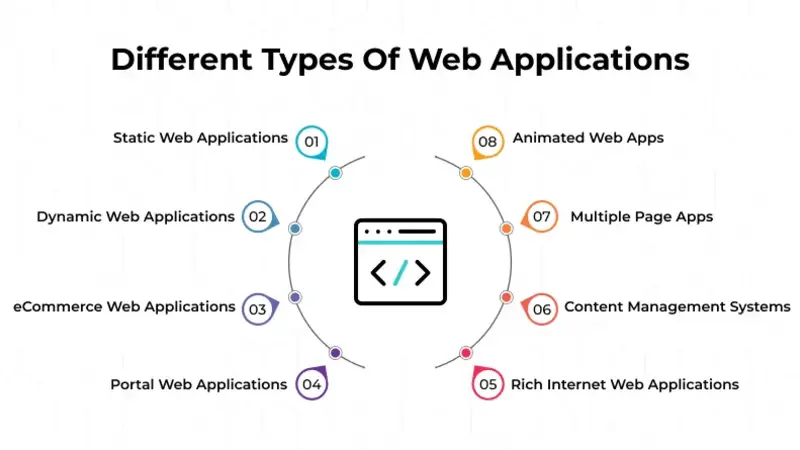Web applications have become an essential part of the modern digital world. They provide users with online access to a wide range of services, and businesses with additional opportunities to interact with their audience. Such applications work through a browser and allow you to solve various problems, from online shopping and financial management to video conferencing.Web app development costs depend on the complexity of the project. The success of a web application depends on the professionalism of the team. In this article, you will learn about the process of developing a successful web application.
Web Application And Website: What Is The Difference?
A web application allows the user to perform an action aimed at a more complex result than just obtaining useful information. This is how it differs from a website. For example, in Google Docs, users can collaborate on text, and you don’t need to refresh the page to see the changes made by another user. In the web version of Skype, users can conduct video calls, and hear and see the other person by granting the web application access to the camera and microphone.
Users do not need to download and install a web application, since it works directly in the browser. This is largely why it is confused with a regular website.
Among other important differences from a website, we can highlight:
- Interactivity and dynamism. Web applications can offer a higher level of interaction with the user, updating content in real time, without the need to reload the page.
- Offline access. Some web applications can cache data and provide limited functionality, even without an Internet connection. This is done using browser caching services and technologies like Service Workers. Examples: Spotify, and Google Drive.
- Using the hardware capabilities of the device. Web applications can access the camera, microphone, geolocation, etc. using the appropriate APIs. Examples: Instagram, WhatsApp Web, Skype web version, etc.
Types of Web Applications
Different types of web applications distribute responsibilities between the server and the client differently. In some cases, the server is fully responsible for the core logic, while in others it is divided almost equally between the server and the client. Each approach has its pros and cons.
Let’s look at the main types of web applications.
PWA Applications
A PWA is a web application that uses new web technologies to provide a user experience similar to a mobile application. A PWA can be installed on the home screen of a smartphone, like a mobile application, but the installation occurs through a browser, not an app store.
The principle of PWA is based on the use of service workers, which cache content and ensure the application works offline. The transition between pages in PWA occurs without reloading the entire page, which provides faster and smoother navigation. The interface adapts to different screens and resolutions.
Advantages of PWA:
- User experience comparable to using a mobile app.
- Faster loading due to content caching.
- Ability to work offline.
- No need to install it from an app store.
- Support for push notifications.
Disadvantages of PWA:
- Not all users know how to install PWA on the home screen; your company’s website will need simple instructions for downloading.
- Limited access to the device’s hardware features compared to native mobile apps.
- uber
MPA Applications
MPA is a traditional approach to web development. Each time a user goes to a new page, the server reassembles it and sends the browser the finished HTML code.
For the user, it looks like this: the content is replaced by a white screen each time, a spinning loading icon appears in the tab, a refresh occurs, and only after that the new page is rendered in parts.
Advantages: for robots, such an application looks like a set of mostly static pages, they can scan its contents and create a sitemap. This is good for SEO.
Disadvantages: with each transition, the page is reloaded (this worsens the user experience).
SPA Applications
SPA works within a single HTML page. This means that the page is loaded once, and when the user moves from section to section, only the content changes.
Advantages: SPA is characterized by fast and smooth navigation, rich user experience, and does not put much load on the server.
Disadvantages: Search robots see such an application as an empty HTML container, and this is bad for SEO. Of course, there are ways to optimize SPA applications for search engines, such as server rendering or pre-rendering.
Other Types of Web Applications
Let’s look at the types of web applications that are less common in implementation, but are suitable for narrower tasks.
Serverless applications are web applications that do not require permanent placement on the server and are executed in the cloud infrastructure when needed. They are automatically scaled depending on the load and are paid only for the actual use of resources. Examples of serverless applications are chatbots, microservices, and webhooks.
WebAssembly applications are web applications that use a new code compilation format that allows high-performance computing on web pages, traditionally available only to native applications. This allows you to create complex web applications, such as games, graphic editors, and multimedia players.
Hybrid applications are products that include features of web applications and native mobile applications. They are developed using web technologies such as HTML, CSS, and JavaScript. Examples of hybrid apps are Instagram, Twitter, and Uber. If you want to read more information visit our website.
Final Thoughts
A web application differs from a static site in its interactivity. It does not simply convey information but allows the user to act with more complex logic. At the same time, it works directly in the browser and opens on any device that has a browser. This is its main advantage. 3 main types of web applications are relevant for domestic businesses: PWA, SPA, and MPA. Each type has its advantages and disadvantages, and the choice of approach depends on your business goals. If you are looking for a reliable company to develop a web application and want to know about the timing and costs, we recommend paying attention to Digiteum.

